Kuih Bangkit is one of the classic Chinese New Year cookies (others are Kuih Kapit @ Love Letter and Pineapple Tarts) loved by Malaysians. What’s loved about this traditional Nyonya cookie is the aromatic smell that welcomes you the moment you bite into the crispy outer layer and then gets jolted into a world of melt in your mouth excitement. Oh yeah!
IMPORTANT ANNOUNCEMENT: I have come to notice quite a few thieves stealing my kuih bangkit photos and using them especially for commerce. Doesn’t matter if you’re using it for personal, on your blog, on your social media, etc, you need to ask permission first. If you’re one of them, you need to take down the photos immediately. I hold the copyright for all the photos on this web site.
This web site & any of its contents (writings, photos, etc) may not be copied, reproduced, reposted, translated, published or distributed in any way (web, electronic or printed) without prior written permission.
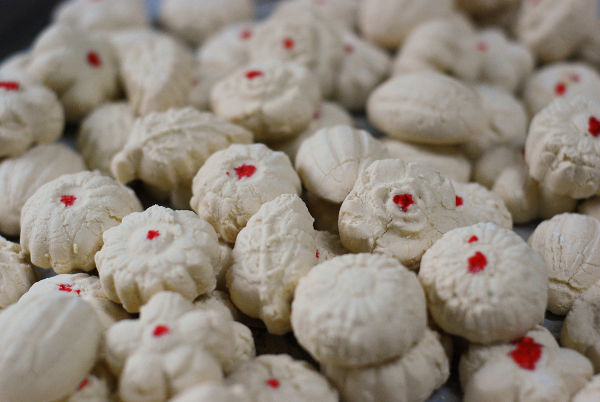
To be frank with you I’m not a big fan of Kuih Bangkit but my sister is such a HUGE fan of this cookie. So much a fan that she stubbornly picked up a cookie that has fallen on the floor and intend to bake it. Horror! Thank God I was able to coax her and finally got rid of that 1 piece of ‘dirty’ cookie. Haha
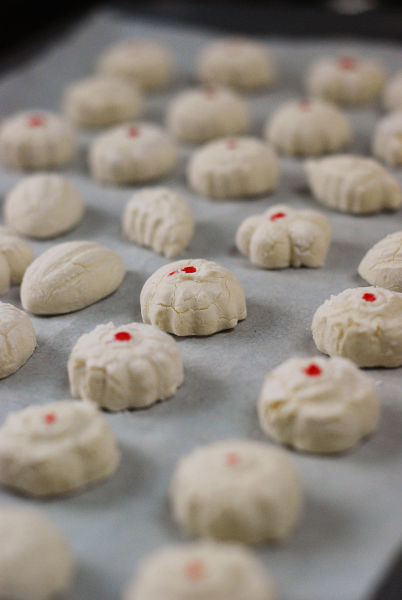
This is our first time baking Kuih Bangkit and I gotta say it was very easy. In my opinion, this is one of the simplest cookies I’ve ever made.
The recipe calls for arrowroot flour (lu-lu hoon) however we couldn’t find it anywhere (not that we look hard enough anyway haha) so we substitute it with sago flour (advice from grandma).

The preparation of ingredients begins a day earlier. Over low fire, you need to fry cornflour, arrowroot flour (in our case sago flour) and pandan leaves in a wok until the flour is light and it doesn’t stick to the side of the wok. This should take about 30 minutes. Transfer the flour to a container and leave it to cool overnight.
A day later…

Whisk egg yolks and caster sugar until thick.
Next, add coconut milk (santan) and stir gradually. We didn’t use all the milk.
Now add enough flour and knead the combination for about 5 minutes to form a pliable dough (means soft and flexible). We also didn’t use all the flour. This is the tricky part. You gotta ‘agak-agak’ (guesstimate).
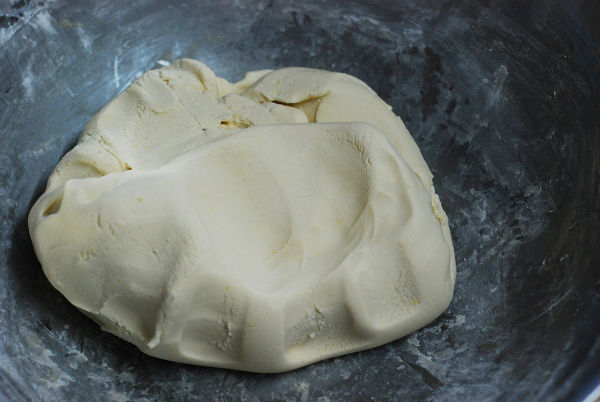
As long as you get a soft & flexible dough then it’s good to go.

We bought 2 plastic kuih bangkit moulds as the wooden ones is 5-6 times pricier. *gags*
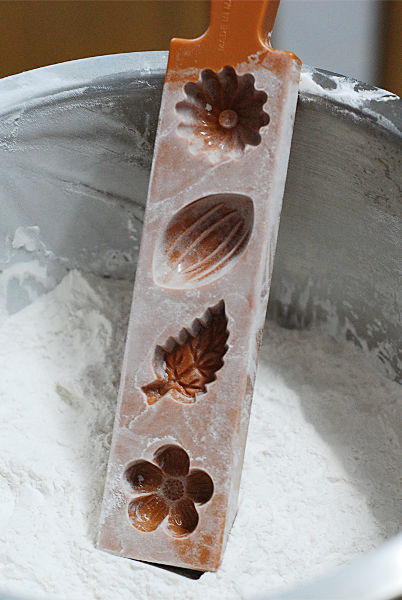
Lightly dust the moulds with the remaining flour. Notice how much flour we have left in the container.

Take a small piece of dough and press it into the mould. Trim the excess dough off with a spatula. In our case, we just use our fingers to trim it. Easy! Haha
Now knock the mould gently on the table to dislodge the cookies.
Arrange the cookies on a baking tray (remember to line it with baking paper) and bake for 10-20 minutes in 150OC. For us, we bake ’em for 25 minutes as we prefer a crisper and brownish outside.
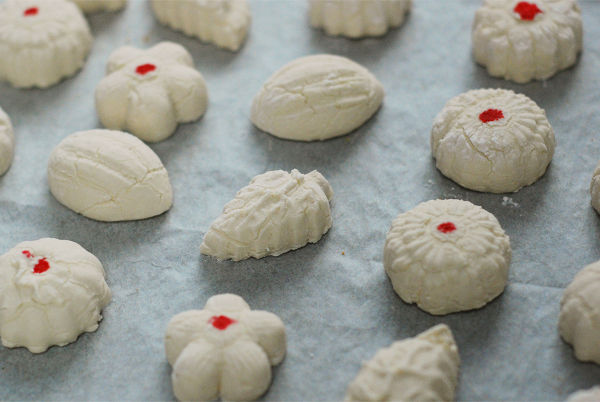
Fresh from the oven. YUM!
Optional: Add a red dot (from red food dye) using a toothpick (I used fork haha) on Kuih Bangkit with flower designs.
Cool them and store them in air-tight containers.
Additional notes & tips:
1. A fascinating fact: During kneading, you can feel the dough become hot. Just some chemistry effect!
2. When you have a ‘wet’ dough, you will find it difficult to dislodge cookies from the mould. Add some flour and re-knead. When you have a ‘hard’ dough, you will find the dislodged cookies in a crumbly state. Add some coconut milk and re-knead. All this shouldn’t be a problem if you follow the method above.

3. Remember to cover the rest of the dough with a damp cloth while you’re busy moulding kuih bangkit as the dough will harden up. In our case, we took a handful of the dough (uncover) for moulding and cover the rest.
4. If the dough does harden up, add a little coconut milk and re-knead the dough.
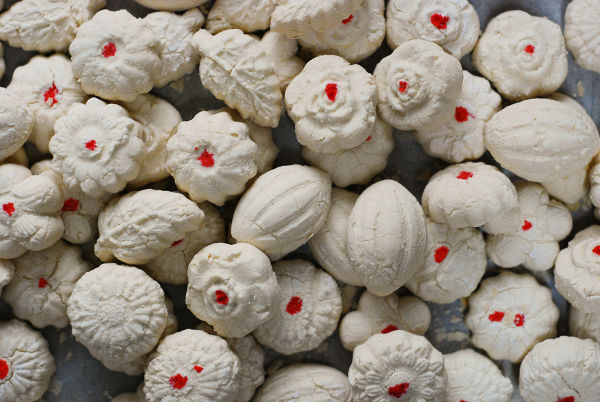
5. Make sure you dust the mould with enough flour. The first or second time is usually the hardest to dislodge the cookies from the mould. After that it’s easy.
6. Because this is the first time we’re making the cookies, we tried baking a few pieces in the oven to adjust the cooking time.
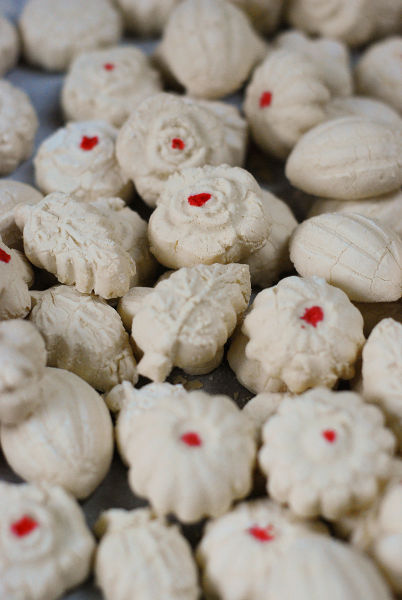
Kuih Bangkit – Chinese New Year Cookies
Adapted from Nyonya Flavors
Yields 140 pieces
150g cornflour
600g arrowroot flour (lu-lu hoon)
1-2 pandan leaves, cut into 3cm lengths
3 egg yolks
150g caster sugar
250ml thick coconut milk, extracted from 1 grated coconut
Method:
1. Over low fire, fry the cornflour, arrowroot flour and pandan leaves in a wok until the flour is light and doesn’t stick to the side of the wok. This takes about 30 minutes. Leave flour to cool overnight.
2. Whisk egg yolks and caster sugar until very thick and add 250ml of coconut milk slowly (you may not need to use all the milk). Then add flour (you may not need to use all the flour) and knead to form a soft pliable dough. Takes about 5 minutes.
3. Dust a wooden kuih bangkit mould with the remaining flour. Place dough and press into each of the designs on the mould. Trim off the extra dough with a spatula. Knock the mould gently against the table to remove the cookies.
4. Place kuih bangkit on lined baking trays. Bake at 150OC (350OF) for 10-20 minutes. If you prefer pale white kuih bangkit, bake for 15 minutes. If you prefer aromatic and crisp cookies, then bake them until just turning brown. Let it cool on a wire rack before storing it in air-tight containers.
Enjoy!




36 Comments
Used to like this cookies but have not tried making it. Seem easy.
i love kuih bangkit..but cant find a nice one in kl. will try urs. thanks
Hi Molly, yeah we thought they were difficult to make too but not anymore after trying it.
Hi Tedlive, do try it and let me know how you find the cookie. Cheers 🙂
oh u have a good blog too… was just at ur che-cheh blog.. u must be busy cooking making at this time of the year… kuih bangkit has always been an all-time fav for me since a kid… think it’s the melt in the mouth effect
typo…. good = food …. but the blog is good too…
cooking = cookie … sorry fingers and mind not working together today
Hi Lechua, I have 3 blogs actually. Haha
I tried baking kuih bahulu/bulu last week but it was a failed attempt. Will try again this week. Cheers! 🙂
I like kuih bangkit! But I prefer pineapple tarts more! Haha!
To me, a good kuih bangkit must have coconut in it. And it must melt in the mouth. Hmmm, yummy!! : )
This brings back all the memories when my grandmother, mom and aunt “kap sau kap keok” make this cookie before CNY for distribution to friends and relatives. I think my mom gave the wooden moulds to my sister. I still remember the prepping of the flour overnight, the actual making of the cookie, and we kids will put the baked cookies in the lined tins….thanks for the memories! 🙂
Hi Foongpc, I only like eating the crust of pineapple tarts. Haha
Do you mean coconut milk?
Hi Dawn, ahh the good ole days ya. For me it’s the kuih kapit that we (including relatives) ‘kap sau kap keok’. Haha
actualy i don’t like all the sweet stuff. but after i had read your article.. very interesting.hope ican tray try this one day.
Hi Leen, where you’re from? This cookie is actually not that sweet. 🙂
YUMMY-LICIOUS….so kind of you for sharing….
Hi Sharon, 🙂 sharing is good.
I have wooden kuih mould @ RM10 each. Collector’s item. Very good condition. Never used. Will add to my above blog later. Meantime, email me if u r interested n check out my blog too.
Where Can I buy the plastic Kuih Bangkit moulds ( with the handle ) in the Chinese New Year Cookies recipe above? All I can find are the seashells and almond slices moulds…
Hi Mayra, you can check ebay.
I did check Ebay and they did not have the ones with 8 different shapes like in your recipe… only the 4 seashells or 4 almond… I really like the 8 different shapes you are using..
Hi Mayra, maybe you can ask the ebay seller whether they can get it for you in different shapes. Or if you want I can get it for you from my local shop here. But I cannot guarantee I will find the exact pattern.
I see the wood ones but I like the plastic ones with the handle
The wood ones were used during my grandma’s period. Nowadays the plastic ones are most famous because it’s lighter.
Ok. Thanks
I wil ask on Ebay and if I cannot find them I will drop you a note.
Ok 🙂
Do you have a Kuih Bangkit cookie in US measurements? not grams.. I just want to bake correctly.. Thanks
Unfortunately no. You can easily convert grams to ounce or cups using online conversion calculator. Thanks 🙂
i used to make these when i was kid with my mum….and for a long time never make it already…after watching your recipe…i think i am going to try and make it ….thanks …it looks yummy!
Sweet childhood memory ya. 🙂
Please try. Hope you like it.
Hi, I’ve recently gone crazy craving for these kuih bangkits and saw many recipes online. But I’m confused as for the same amount of flour, some advised to add only 1 egg yolk, some advised 8 egg yolks, some 4 and in your case, 3. Some advised to add egg white from 1 egg… I tried with 4 egg yolks, it turned out crispy. Didn’t melt on mouth. I tried 1 egg yolk. Was slightly crispy on the outside and take a little effort to melt in the mouth. Does yours melt in the mouth or do we need to chew the kuih bangkit a little? Can’t wait for hear from you soon! I’ve decided to bake tonight… >=)
Hi,
This recipe is crispy on the outside and ‘some’ melt in the mouth inside. You do have to chew the kuih bangkit. Good luck.
Hi there, as in my memories all kuih bangkit was made of 薯粉 (Tapioca).. i was wondering what is arrowroot flour (lu-lu hoon)? is there any chinese name? thanks in advance! 😛
Hi Aki, I’m not sure what they call arrowroot flour in Chinese other than lu-lu hoon (as mentioned in the book). According to the book author, arrowroot flour is available in Penang only. We normally use sago flour instead.
[…] 4. Kuih Bangkit Recipe: Messy Witchen […]
Very lovely blog
Thank you Victoria. 🙂
Hello CheCheh!
Must the fried flour be left overnight? Can it be used once it’s cooled?
Hi Roxane, it needs to be cooled overnight because it takes that long for the flour to cool down.